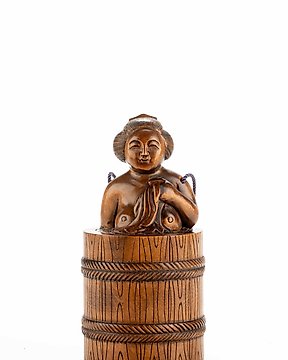
Λάκα, Ξύλο - Ένα όμορφα σκαλισμένο ξύλινο tonkotsu που απεικονίζει μια γαλήνια γυναίκα σε ένα λουτρό onsen - Shōwa period (1926-1989)
Αρ. 83622363

Αρ. 83622363

This is a kokeshi doll made by Sei Onuma 大沼誓(1890~1960).
A kokeshi craftsman who was active during the Meiji period.
This is his later work. It's rare.
[People] Born on December 25, 1891, the second son of Yasutaro Onuma and Toyo Onuma in Naruko, Tamatsukuri District, Miyagi Prefecture. His grandfather was Kangorō Onuma, who is recorded as a lacquer artist in the Sawaguchi Gozaemon document. Yasuyoshi, a disciple of his father, Yasutarō, married Riemon Onuma's daughter, Mie, and became Riemon's adopted son. Kantaro, Ou's older brother, had studied woodworking with Rishiro Takahashi.
Sei Onuma dropped out of Naruko High School after one year and became a disciple of Kanji Takahashi at the age of 13, learning woodworking. Kanji was the younger brother of Kesano, Riemon's wife. At the time of his disciple, Sei was actively grinding horse's butt balls, Japanese sesame seeds, etc.
In Kanji's workshop at that time, there was a potter's wheel with a large wheel about 6 feet long, and Ou and his brother and son, Onuma Hiranai, held the handle of the large wheel and turned it together, and Kanji It is said that he exclusively sawed the bare wood.
The winter after he became an apprentice, he climbed Karasukawa (a mountain on the border with Miyazaki Village, Kami District), built a mountain hut, stayed overnight, and joined in the mountain work sawing wood for many days. The work was too demanding for a 14-year-old, and it also broke his stomach, so he ran away from the mountain. Afterwards, since he could not return to Kanji, he went to Shikanohara, Kami District and sawed mainly the horizontal wood.
He entered military service in 1902, and after being discharged in 1909, he returned to Naruko and worked for Kamesaburo Takahashi, making toys for about two years. In Takagame, one person was considered to be able to make 60 6-inch kokeshi dolls in a day.
After that, he worked for seven years in Urushisawa, Naruko, and Nakayama Byōdō, grinding wood products such as tea chests and trays.
His body wasn't naturally strong, so working in the woodlands in the winter was tough. He once got sick and took a long leave of absence. Afterwards, he worked in a sulfur mine and sawn wood little by little.
He and his wife Rin had four sons, but both the eldest and second son died when he was two years old, and the third son died in Manchuria when he was 20 years old. His fourth son Chikara became Kiji's disciple after the war and succeeded him.
Bunsaku Tachibana's ``Kokeshi and the Author'' was the first to introduce his works as a kokeshi maker along with photographs. Kaname Fukazawa visited Oi in 1944 and Minekichi Nishida in 1952, and took notes.
Around 1945, he installed a potter's wheel at his home and resumed making his own kokeshi dolls.
Most of the kokeshi dolls that have come into the hands of collectors have been made since 1945, but some have been passed into the hands of children and used as toys, and some have small, Kina-kina-style dolls decorated with paintings. There are rare kokeshi dolls that are believed to be from the Taisho period.
Around 1945, he quit mining and became a full-time woodworker.
He continued to make kokeshi dolls even after the war, but passed away on December 8, 1960 at Naruko Shinyashiki. He is 71 years old.
This is an old traditional Japanese kokeshi doll.
This is called Naruko Kokeshi from Miyagi, Japan.
Kokeshi dolls are classified as medium to large size.
size
Height 30cm Width 8cm Weight 670g
Πώς να πραγματοποιήσετε αγορές στην Catawiki
1. Ανακαλύψτε κάτι ιδιαίτερο
2. Υποβάλετε την κορυφαία προσφορά
3. Πληρώστε με ασφάλεια